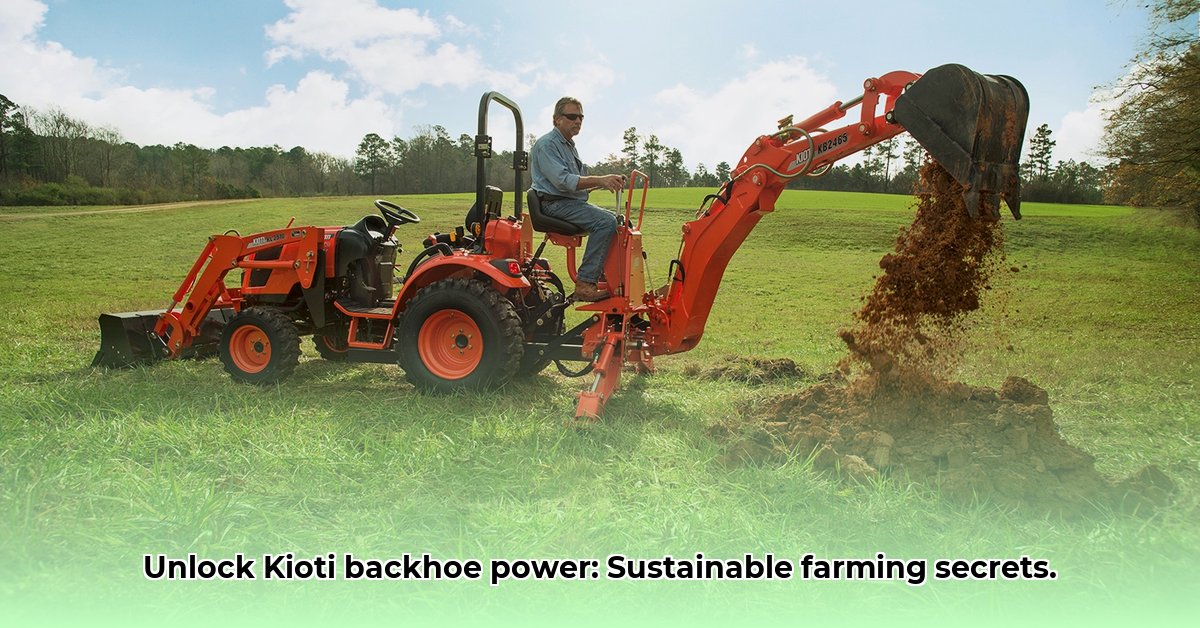
Kioti Tractor Backhoes: Partners in Sustainable Agriculture
Farming demands efficiency and sustainability. The Kioti tractor backhoe offers a compelling blend of both, promising increased productivity while minimizing environmental impact. However, understanding its true contribution to sustainable agriculture requires a nuanced perspective. This article explores the Kioti backhoe's capabilities, limitations, and the path toward optimizing its use for environmentally responsible farming. To learn more about Kioti's manufacturing, visit Kioti Tractor Origins.
How can farmers effectively leverage the Kioti backhoe to enhance both yield and environmental stewardship? The answer lies in understanding its versatility and implementing smart farming practices.
One farmer, using a Kioti CK20 HST with a backhoe attachment, successfully cleared a 2000 sq ft area, removing soil and roots from dozens of mature trees. This highlights the machine’s surprising power for smaller-scale land clearing. However, larger projects might necessitate additional equipment and careful planning, which underscores the importance of assessing the project scope before starting work and evaluating the true cost-benefit of utilizing a CK20 over a larger tractor.
The Kioti Advantage: Versatility and Efficiency
The Kioti backhoe's strength lies in its adaptability. It's not just for digging; it handles material movement, fence building, and various other farm tasks. This versatility reduces the need for multiple specialized machines, saving time, fuel, and operational costs. This increased efficiency directly contributes to sustainable farming practices by minimizing resource consumption.
But how does this translate to tangible environmental benefits? While a Kioti backhoe doesn’t directly neutralize environmental concerns, its efficiency contributes to reduced fuel consumption which is tied to lower carbon emissions compared to using multiple pieces of farm equipment. Consequently, minimizing land disruption and promoting soil health is a key aspect of sustainability.
"Smart backhoe use helps prevent soil compaction," notes Dr. Emily Carter, Professor of Soil Science at the University of California, Davis. "The less we disturb the soil structure, the healthier its microbial population becomes. This, in turn, enhances nutrient cycling and water retention."
Optimizing Kioti Backhoe Use for Sustainability
To maximize the Kioti backhoe's contribution to sustainable farming, consider these actionable steps:
- Assess Your Needs: Carefully evaluate your farm's specific needs and identify tasks where a Kioti backhoe can improve efficiency. This should include an honest assessment of the job's size and scope, considering whether a Kioti tractor is suitable or a heavier-duty machine might offer better value.
- Choose Sustainable Attachments: Select implements prioritizing conservation tillage and precision farming. These minimize soil disturbance and reduce the need for extensive chemical use.
- Prioritize Soil Health: Employ techniques to minimize soil compaction during backhoe operations. The health of your soil contributes directly to improved crop yields and a reduced need for input chemicals.
- Monitor Fuel Consumption: Track fuel usage to identify areas for improvement and measure your progress towards reducing environmental impact.
- Embrace Continuous Improvement: Regularly review your farming practices, seeking ways to enhance efficiency and reduce your environmental footprint.
Measuring Environmental Impact: A Call for Further Research
While anecdotal evidence suggests reduced emissions, quantifying the Kioti backhoe's precise environmental impact requires more thorough research. Future studies should focus on:
- Fuel Consumption Analysis: Detailed data comparing fuel usage per task across various soil types and farming applications is needed.
- Soil Compaction Assessment: Pre- and post-operation soil testing can quantify compaction levels and their impact on long-term soil health.
- Greenhouse Gas Emission Quantification: Accurately estimating CO2 emissions from fuel use requires detailed data and sophisticated modeling.
The Future of Sustainable Farming: Technology and Innovation
The agricultural landscape is evolving rapidly. Farmers increasingly seek technology and tools that enhance sustainability, and the Kioti backhoe, when used strategically, can play a critical role in this evolution. This requires a commitment to ongoing improvement, data-driven decision-making, and a focus on minimizing environmental impact. The journey towards sustainable farming is ongoing; but with mindful practices and the right tools, we can move towards a more resilient and environmentally responsible agricultural future.